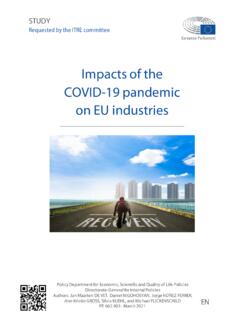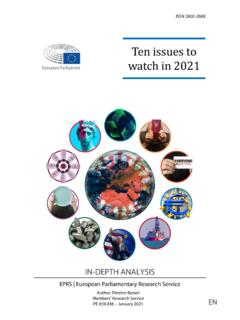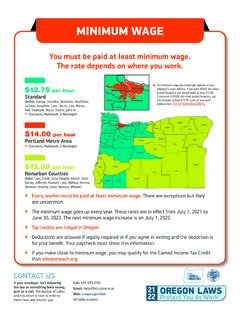Transcription of VII. FOREIGN DIRECT INVESTMENT RESTRICTIONS IN OECD …
1 1 VII. FOREIGN DIRECT INVESTMENT RESTRICTIONS IN OECD COUNTRIES Introduction and summary Inward FOREIGN DIRECT INVESTMENT has often been restricted Attitudes and policies towards liberalisation of international capital flows have been subject to considerable This is because free capital movements raise concerns about loss of national sovereignty and other possible adverse consequences. FOREIGN DIRECT INVESTMENT (FDI), even more than other types of capital flows, has historically given rise to such concerns, since it may involve a controlling stake by often large multinational corporations over which domestic authorities, it is feared, have little power.
2 For these reasons, governments have sometimes imposed RESTRICTIONS on inward FDI. In recent decades, however, an increasing consensus on the benefits of inward FDI has led to reconsideration of these RESTRICTIONS and this has been reflected in formal agreements on such capital flows (Box ). Box International INVESTMENT agreements Formal international agreements on FOREIGN DIRECT INVESTMENT are far less extensive than on international trade, despite the importance of FDI in the world economy. However, the 1990s have seen a substantial rise in the number of bilateral INVESTMENT protection treaties, and regional and bilateral trade agreements in which INVESTMENT disciplines figure prominently.
3 These agreements include NAFTA, the recent agreements concluded by Singapore with EFTA, Japan and Australia and the Association Agreement between the European Community and Chile. The European union had already completely liberalised intra-EU capital movements in the late 1980s. The OECD has been an important actor in international discussions and agreements on At present the OECD code of Liberalisation of Capital Movements forms the only multilateral framework in force on international capital flows, including FDI. Under the code , countries bind themselves to agreed measures liberalising capital movements.
4 Moreover, under the OECD Declaration on International INVESTMENT and Multinational Enterprises, the 30 OECD countries and 7 non-OECD adhering countries are committed to accord national treatment to FOREIGN enterprises operating in their territories and to encourage their multinational enterprises to engage in responsible business conduct in a variety of areas. 1. See OECD (2002a) for an overview of policies towards international capital mobility, with a focus on the experience of OECD countries. 2 There are several INVESTMENT -related provisions in the agreements related to the World Trade Organisation.
5 The Uruguay Round led to an agreement on Trade Related INVESTMENT Measures (TRIMS) that restricts inter alia domestic-content requirements. The General Agreement on Trade in Services (GATS) covers all modes of service delivery, including commercial presence which is closely related to FDI. The GATS commitments, however, apply only to industries where countries have explicitly agreed to open their markets to FOREIGN providers. In 1996, the WTO also created the Working Group on the Relationship Between Trade and INVESTMENT , a forum for discussion among WTO countries. At the Doha Ministerial Conference in November 2001, the WTO members agreed on the principle of undertaking negotiations on a multilateral framework after the 2003 WTO ministerial meeting at Cancun (see OECD, 2002b).
6 _____ 1. Further discussion of OECD experience with INVESTMENT rules and multilateral initiatives concerning FDI can be found at and in Graham (2000), Robertson (2002) and Sauv and Wilkie (2000). This chapter shows that RESTRICTIONS on FDI This chapter reviews RESTRICTIONS on FDI inflows in OECD countries. The barriers covered include limitations on FOREIGN ownership, screening or notification procedures, and management and operational RESTRICTIONS . The main findings are as follows: .. generally Overall FDI RESTRICTIONS are generally low in the OECD area at present but important in the case of a few countries.
7 Concentrated in the service FDI RESTRICTIONS are concentrated in service sectors with almost no overt constraints in manufacturing.. and have fallen since 1980 Barriers to FOREIGN ownership have significantly fallen in virtually all OECD countries over the past two decades. The different types of FDI barriers Formal RESTRICTIONS on FDI include limits on FOREIGN RESTRICTIONS on FOREIGN ownership are the most obvious barriers to inward FDI. They typically take the form of limiting the share of companies equity capital in a target sector that non-residents are allowed to hold, to less than 50 per cent, or even prohibit any FOREIGN ownership.
8 Examples of majority domestic ownership requirements include airlines in the European union and North American countries, telecommunications in Japan, and coastal and freshwater shipping in the United States. Exclusive domestic ownership is also often applied to natural resource sectors with the aim of giving citizens access to the associated rents. For example, FOREIGN ownership is banned in the fishing and energy sectors in Iceland, and in the oil sector in Mexico. Although not specifically aimed at excluding FOREIGN shareholders, statutory state monopolies are tantamount to a ban on FOREIGN INVESTMENT .
9 Screening and approval Obligatory screening and approval procedures can also be used to limit FDI though their constraining effects depend on the implementation of such practices. Stipulations that FOREIGN investors must show economic benefits can increase the cost of entry and therefore may discourage the 3 inflow of FOREIGN capital. Such provisions apply, for instance, for a few industries in Japan and for the acquisition of more than 49 per cent of any existing enterprise in Mexico.
10 Prior approval of FDI, such as mandated for all FDI projects in a few OECD countries, could also limit FOREIGN capital inflow if it is taken as a sign of an ambivalent attitude towards free FDI, even though it may not be vigorously enforced. Simple pre- or post-notification (as required in Japan) is, however, unlikely to have much impact on capital inflows.. and constraints on FOREIGN personnel and operational freedom Other formal RESTRICTIONS that can discourage FDI inflows include constraints on the ability of FOREIGN nationals either to manage or to work in affiliates of FOREIGN companies and other operational controls on these businesses.















